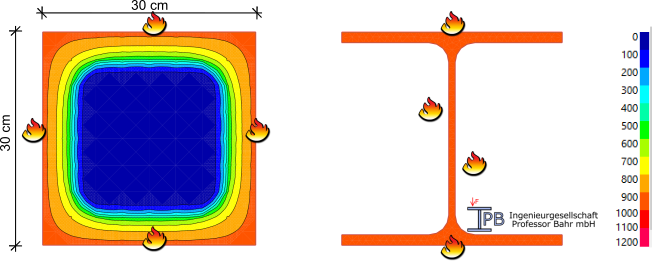Thermal conductivity of structural steel
What is the thermal conductivity?
The thermal conductivity λ is a measure of how well a material transports heat (i.e. thermal energy) by means of thermal conduction. The lower the value of the thermal conductivity, the better the thermal insulation. In the SI system, the thermal conductivity has the unit watt per meter and Kelvin ( W / m⋅K ). Materials with high electrical conductivity also tend to have high thermal conductivity and vice versa. As always exceptions confirm the rule: diamond, for example, has a very high thermal conductivity of λ = 2000 W / m⋅K (in comparison: structural steel has a thermal conductivity of "only" 50 W / m⋅K and is still an excellent electrical insulator.
What is thermal conductivity important for in construction?
In construction, the thermal conductivity in the range of "normal" ambient temperatures is particularly important for the thermal insulation of buildings, in which, of course, poorly conductive, i.e. insulating materials are selected for the building envelope. In industrial halls in which work is carried out and which must therefore not be too cool, the roof and wall construction often consist of sandwich profiles. These consist of an insulating core (e.g. made of polyurethane foam or mineral wool) and two metallic cover layers.
Also in the constructive fire protection , the thermal conductivity is of great importance. In the fire design of members usually the temperature range from 20°C to 1200°C must be examined. The background to this is that adequate fire protection (the so-called fire resistance duration) is based on a specific fire room curve, the so-called ISO standard fire.

of a steel and a wood cross-section according to the ISO standard fire.
Why is the high thermal conductivity of steel a disadvantage in the event of a fire?
In the event of a fire as well as in the thermal insulation of buildings to save energy, steel does poorly without further measures. This is due to its high thermal conductivity of approx. λ=50 W/m⋅K. For comparison: the thermal conductivity of wood is approx. λ=0,13 W/m⋅K. As a result, steel structures represent thermal bridges at normal temperatures. And in the event of a fire, steel heats up very quickly and loses strength and elasticity. The figure shows a thermal analysis of steel and wood in the event of a fire. The two cross-sections were exposed to the ISO standard fire on all sides for 60 minutes. It can be clearly seen that the steel cross-section has almost uniform temperatures in the very high range, while the wood cross-section still benefits from many cool areas.
It should not be left unmentioned that stainless steels have a significantly more favourable material behaviour in the event of a fire as the thermal conductivity of stainless steel is significantly lower than that of structural steel.
Where is the thermal conductivity of steel regulated by standards?
The thermal and mechanical material properties of structural steel exposed to fire can be found in EN 1993 -1-2. You can find an evaluation of the corresponding equations from 20° C to 1200° C here.
These material laws are stored in special programs for the fire design of members. The programs use the thermal material parameters for the thermal analysis, while they use the mechanical material parameters for the mechanical analysis.
Can unprotected steel structures still be made fire-proof?
Under certain circumstances it is also possible to build unprotected steel structures in a fire-proof manner. We offer you a short-term fire design. The documentation contains the essential information on the heating of the cross-section, the fire resistance duration of the member as well as its deformations. Further services can of course be provided in consultation with you.
What are your benefits?
Our clients often save costs by using sophisticated fire design. In the case of new buildings, leaner and therefore more economical constructions can be carried out. In the case of existing structures extensive upgrading measures can often be avoided by an accurate fire design.
My initial consultation for your project
To clarify your specific task, it is best to call me. Or you can send me an e-mail with some key data. On this basis, we can discuss the framework conditions and I can create an attractive offer for you.